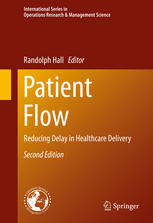

Most ebook files are in PDF format, so you can easily read them using various software such as Foxit Reader or directly on the Google Chrome browser.
Some ebook files are released by publishers in other formats such as .awz, .mobi, .epub, .fb2, etc. You may need to install specific software to read these formats on mobile/PC, such as Calibre.
Please read the tutorial at this link: https://ebookbell.com/faq
We offer FREE conversion to the popular formats you request; however, this may take some time. Therefore, right after payment, please email us, and we will try to provide the service as quickly as possible.
For some exceptional file formats or broken links (if any), please refrain from opening any disputes. Instead, email us first, and we will try to assist within a maximum of 6 hours.
EbookBell Team

4.8
24 reviewsThis book is dedicated to improving healthcare through reducing delays experienced by patients. With an interdisciplinary approach, this new edition, divided into five sections, begins by examining healthcare as an integrated system. Chapter 1 provides a hierarchical model of healthcare, rising from departments, to centers, regions and the “macro system.” A new chapter demonstrates how to use simulation to assess the interaction of system components to achieve performance goals, and Chapter 3 provides hands-on methods for developing process models to identify and remove bottlenecks, and for developing facility plans.
Section 2 addresses crowding and the consequences of delay. Two new chapters (4 and 5) focus on delays in emergency departments, and Chapter 6 then examines medical outcomes that result from waits for surgeries. Section 3 concentrates on management of demand. Chapter 7 presents breakthrough strategies that use real-time monitoring systems for continuous improvement. Chapter 8 looks at the patient appointment system, particularly through the approach of advanced access. Chapter 9 concentrates on managing waiting lists for surgeries, and Chapter 10 examines triage outside of emergency departments, with a focus on allied health programs
Section 4 offers analytical tools and models to support analysis of patient flows. Chapter 11 offers techniques for scheduling staff to match patterns in patient demand. Chapter 12 surveys the literature on simulation modeling, which is widely used for both healthcare design and process improvement. Chapter 13 is new and demonstrates the use of process mapping to represent a complex regional trauma system. Chapter 14 provides methods for forecasting demand for healthcare on a region-wide basis. Chapter 15 presents queueing theory as a method for modeling waits in healthcare, and Chapter 16 focuses on rapid delivery of medication in the event of a catastrophic event.
Section 5 focuses on achieving change. Chapter 17 provides a